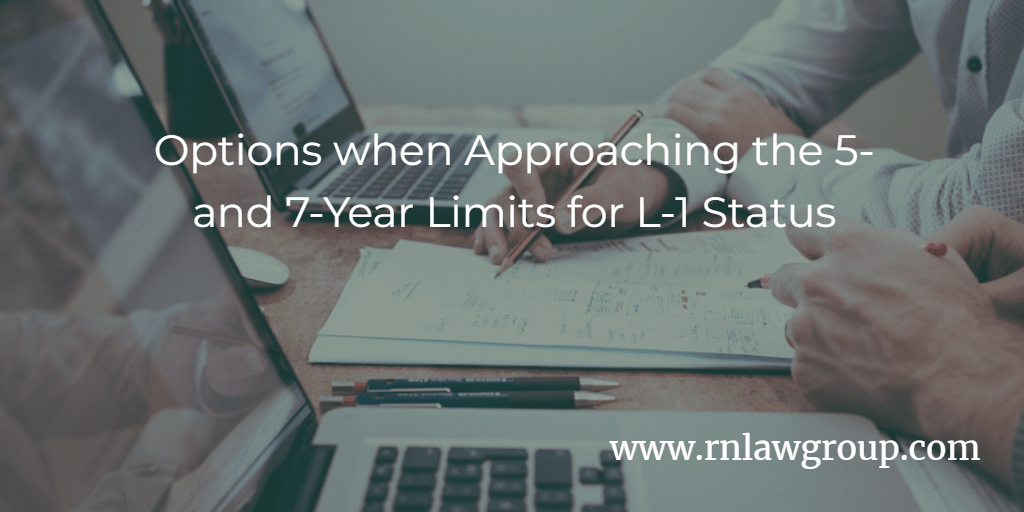
Options when Approaching the 5- and 7-Year Limits for L-1 Status
For multinational organizations, the L-1 visa is a useful tool to transfer employees from foreign affiliates to their U.S. office to fill managerial/executive (L-1A) or specialized knowledge (L-1B) roles. Companies that successfully transfer multinational workers to the U.S. should be aware of the statutory limits on the duration of L-1 status, and plan ahead for actions to extend, change, or adjust their workers’ status if they intend to employ them in the U.S. beyond the limit.
The 5- and 7-Year Limits
The maximum amount of time an individual can remain in the U.S. is 5 years for L-1B workers, and 7 years for L-1A workers. The initial approval duration for both visa categories is typically 3 years, followed by extensions in 2-year increments.
It is important to note that USCIS measures the actual amount of time that the employee has been physically in the U.S. in L-1 status – so while an I-797 approval notice may list a certain start date for the validity period, the limit probably will not be exactly 5 or 7 years from that date. If the beneficiary is outside the U.S. at the time the first petition is approved, the start date on their use of L-1 status will likely be later that the I-797 validity date if they need to apply for a visa at the consulate and travel into the U.S. Their L-1 clock will be considered to start running from the date they land in the U.S. to start their L-1 employment. In addition, any time they spend outside the U.S. after starting their L-1 employment may be recaptured and accounted for in future extension of status petitions.
Re-starting the Clock
For an employee who has or will max out their L-1 duration of stay, one way to enable them to resume work in the U.S. in the future is to have them exit the U.S. and remain abroad for at least one continuous year; doing so will re-start the clock and make the employee eligible for a new 5- or 7-year period of stay in the U.S. In order to be eligible for a new period of stay, the employee must remain physically outside the U.S. for a full calendar year; their entry into the U.S. in any other status (such as B-1/B-2) would interrupt the one year calculation.
Changing Status
For employees whose work in the U.S. cannot be interrupted by a one-year stint abroad, changing their nonimmigrant status is a common option as they approach their 5- or 7-year L-1 limit.
L-1B to L-1A
For specialized knowledge employees in L-1B status, one way to extend their stay beyond 5 years is evaluating whether they now qualify for L-1A classification. If their role in the U.S. has evolved to the point that they now meet the definition of an L-1A manager or executive, they may apply for a change of status to L-1A for 2 additional years.
L-1 to H-1B
The H-1B visa is also a popular option for L-1 employees seeking to extend their stay in the U.S., if the position qualifies as a specialty occupation and the employee possesses a bachelor’s degree or equivalent experience. For individuals in H-1B status, there is a statutory limit of 6 years for their duration of stay, and any time spent in the U.S. in L-1 status also counts towards that calculation (resulting in a 6-year cap on total combined H/L status). While H-1B status might only afford an L-1B worker one additional year of stay, one significant advantage of H-1B status is that it may be extended beyond the 6-year limit if the employee has reached a certain point in the green card process (discussed in more detail below). An employee with an approved I-140 immigrant petition or a PERM labor certification that has been pending for more than one year can therefore change their status to H-1B and apply for extensions beyond the 6-year limit on the basis of their green card process.
The change of status to H-1B and extensions based on green card sponsorship is also an option for L-1A employees, with one important caveat – managers/executives who have spent more than 6 years in the U.S. are not eligible to change their status to H-1B, even if they have an approved I-140 petition. This is because USCIS considers that the 6-year statutory limit has already been reached for H-1B purposes. Employees in L-1A status who are considering a move to H-1B classification therefore must do so before reaching their 6th year of L-1A status, despite the 7-year overall limit on L-1A status.
Employers must also keep in mind that if they are not exempt from the H-1B cap (institutions of higher education and their affiliates, or nonprofit research organizations), then changing any employee to H-1B status for the first time requires their selection in the annual H-1B lottery. Due to the nature of the lottery, it is never certain when or whether an employee will be selected, and it may take registering them over multiple years until they are selected and approved. It is therefore strongly advised that employers begin submitting their L-1 candidates in the H-1B lottery earlier rather than later, in order to give them as many opportunities as possible for selection before they reach the 5- or 6-year limit.
L-1 to E-1/E-2
For nationals of certain treaty countries, the E-1 and E-2 visas are potential options that avoid the H-1B lottery and are not duration-limited. E-1/E-2 visa classification does require that the beneficiary hold the same nationality as the treaty trader/investor, and the documentation required to establish the U.S. entity as a trader or investor can be extensive for the initial application. However, the categories of E visa employees (managers/executives and specialized skill employees) correspond closely to the L-1A and L-1B categories, and if approved, the E visa allows for indefinite 2-year extensions of status, as long as the employee continues to demonstrate nonimmigrant intent.
Green Card Sponsorship
As discussed above, the employer-sponsored green card process, in conjunction with a change of status to H-1B, is a common strategy to employ L-1 workers in the U.S. longer-term. This route is particularly necessary for nationals of countries with significant green card queues, primarily India and China, as there will be several years between completion of the employer-sponsored portions of the green card process (PERM and I-140 approval), and the employees’ final adjustment of status to permanent residence. It is therefore particularly important for employers of Indian and Chinese L-1 employees to plan ahead for their longer-term work in the U.S., and begin the PERM labor certification sufficiently early (by the 3rd year of L-1 status, at the latest) in combination with early submission in the H-1B lottery.
For nationals of countries without a significant backlog, early green card sponsorship could result in the employees’ receipt of their permanent residence, or at least the EAD card associated with the processing application, prior to their reaching the 5- or 7-year L-1 status limit. Nationals of non-backlogged countries may therefore be able to forego a change of status entirely through early initiation of their permanent residence process.
The long-term U.S. employment of an L-1 transferee therefore requires careful planning, which may require the initiation of other visa or green card processes well before the 5- or 7-year statutory limits. The U.S. sponsoring company is encouraged to consult with an immigration attorney early in the L-1 worker’s employment in order to assess the options and to make necessary arrangements.
By: Rebecca Chen
Rebecca Chen is a Partner at Reddy & Neumann. Her representation includes advising clients throughout the non-immigrant and immigrant visa application process, from initial filing, responding to various requests for evidence, and processing at overseas consulates. Her years of experience in the immigration field have made her a knowledgeable resource for complex business immigration matters.

